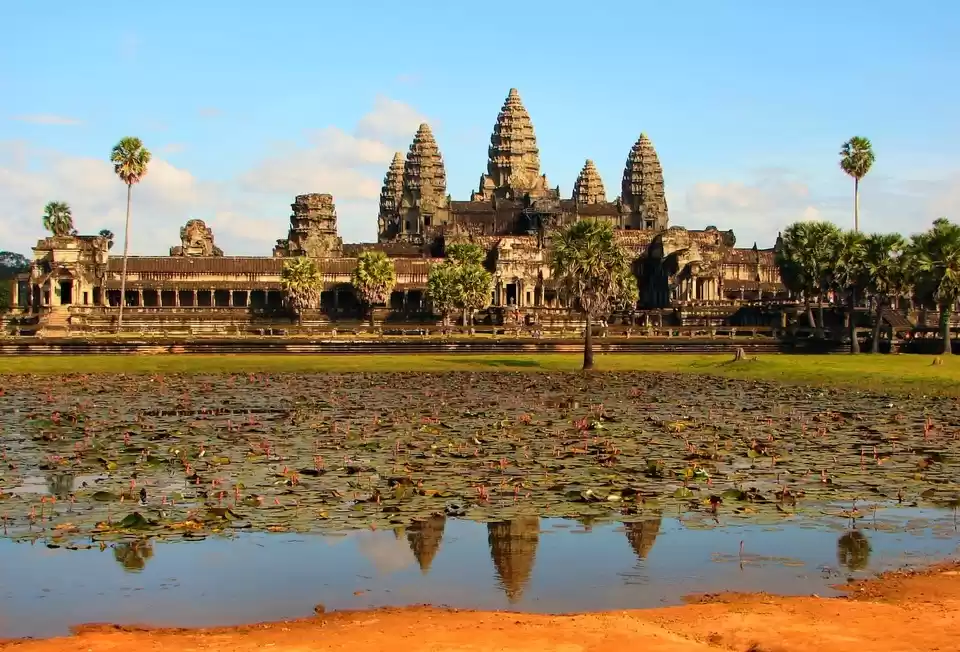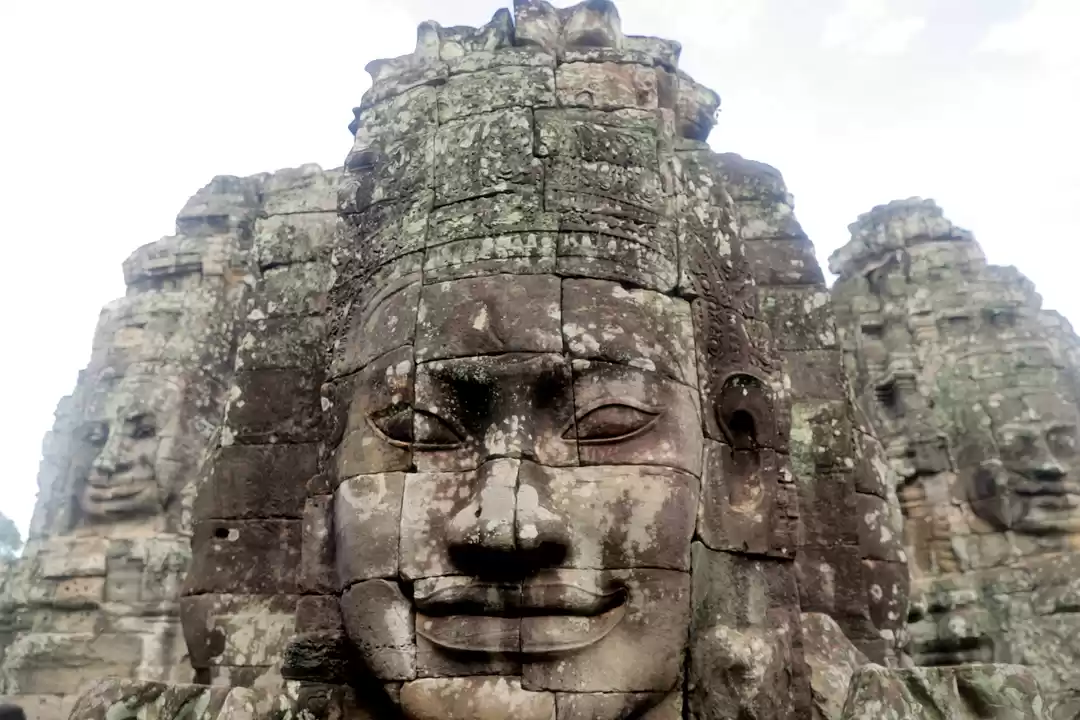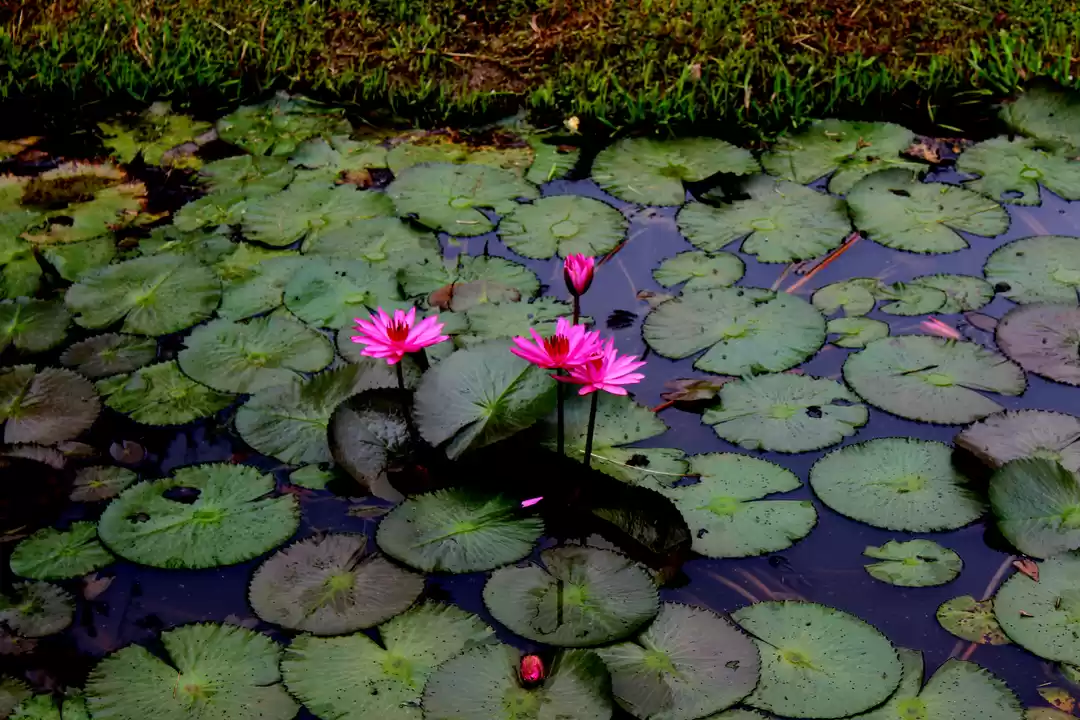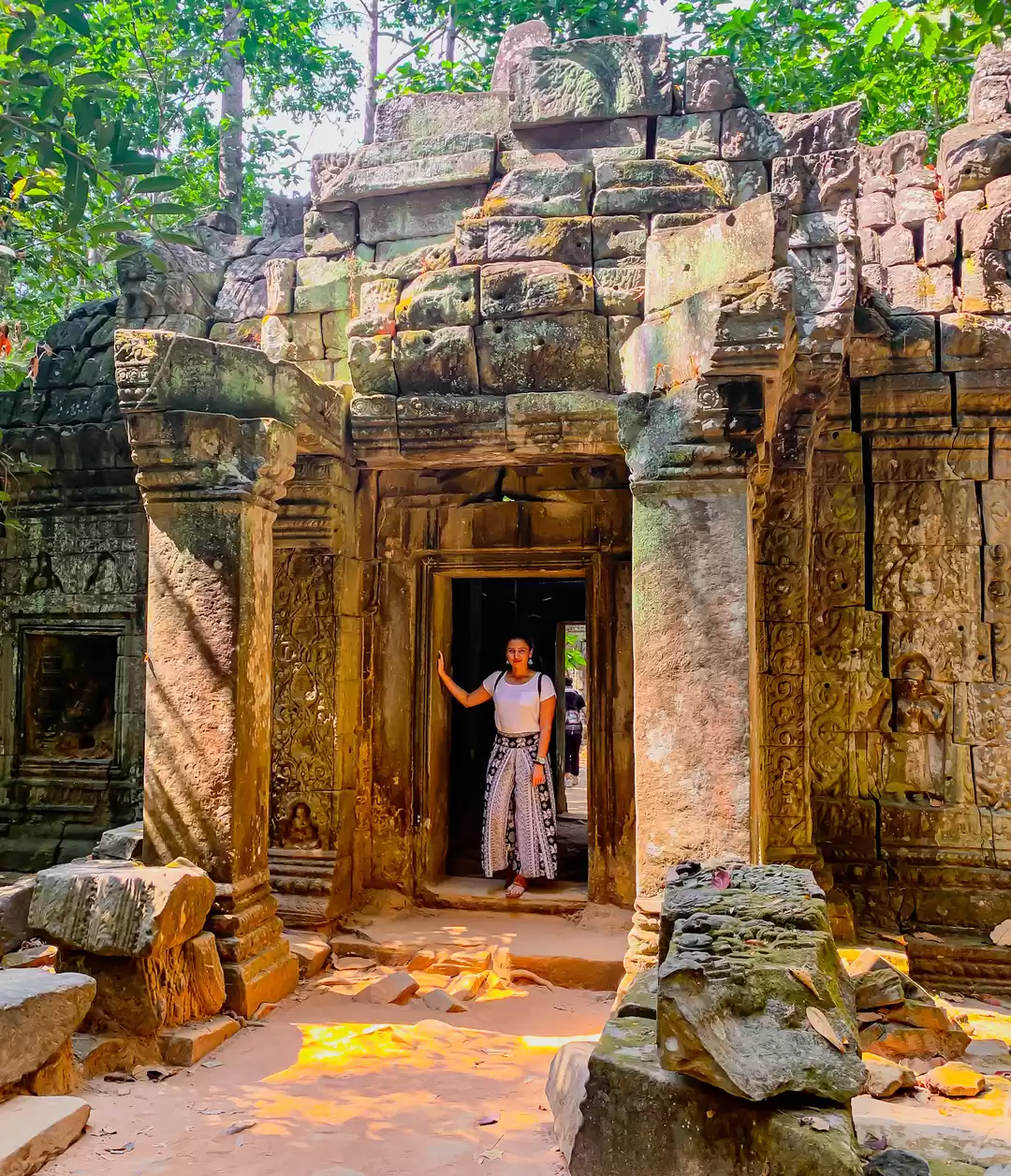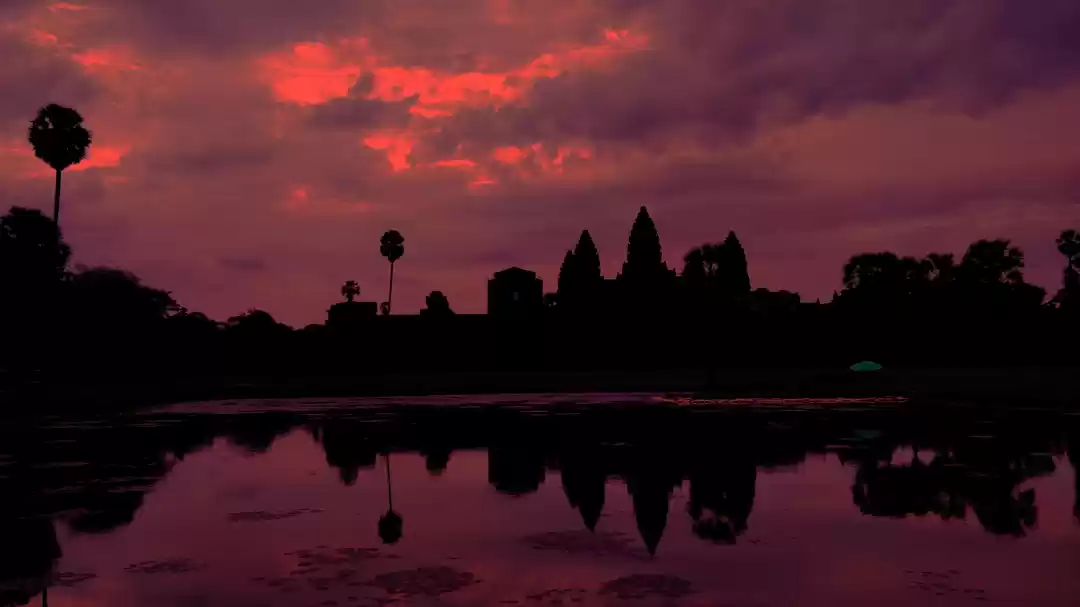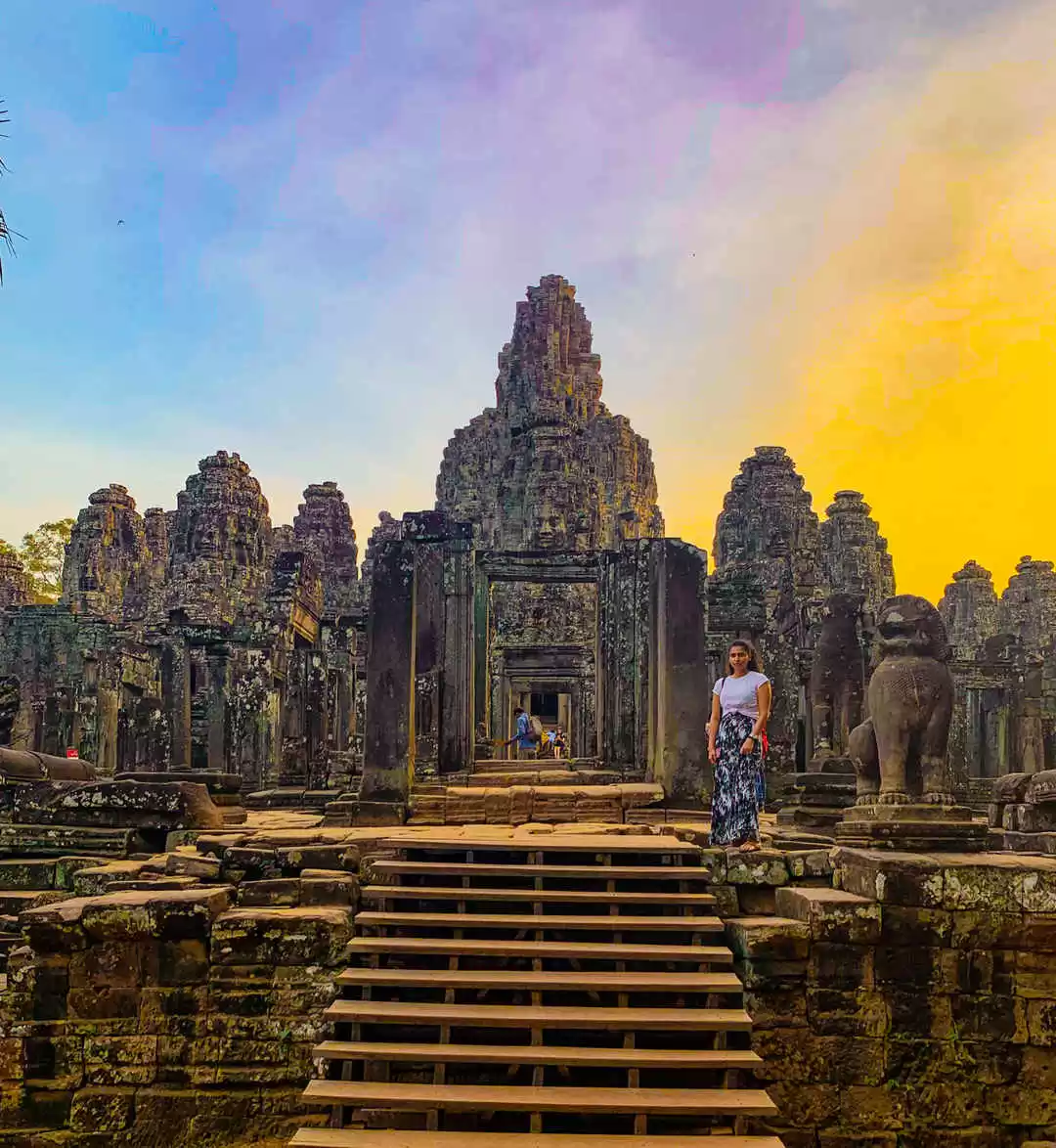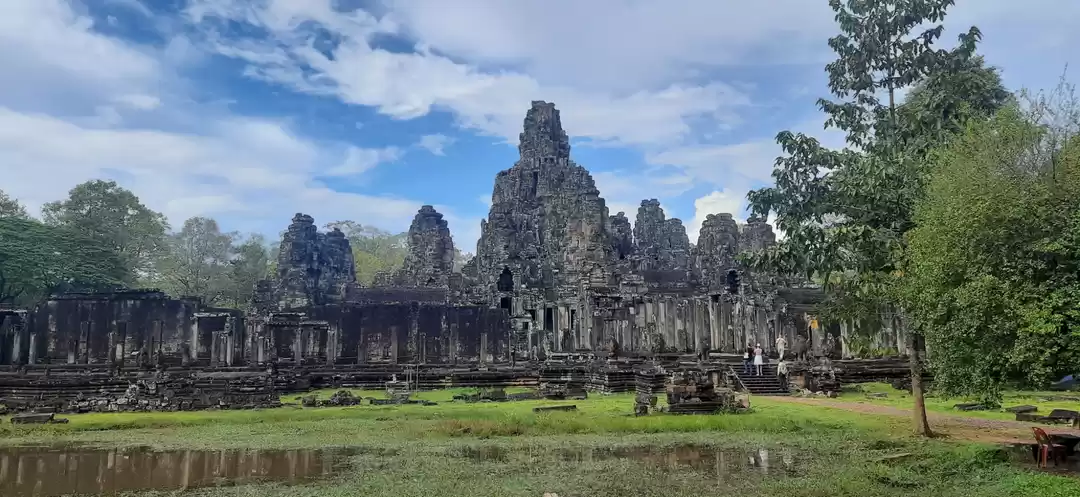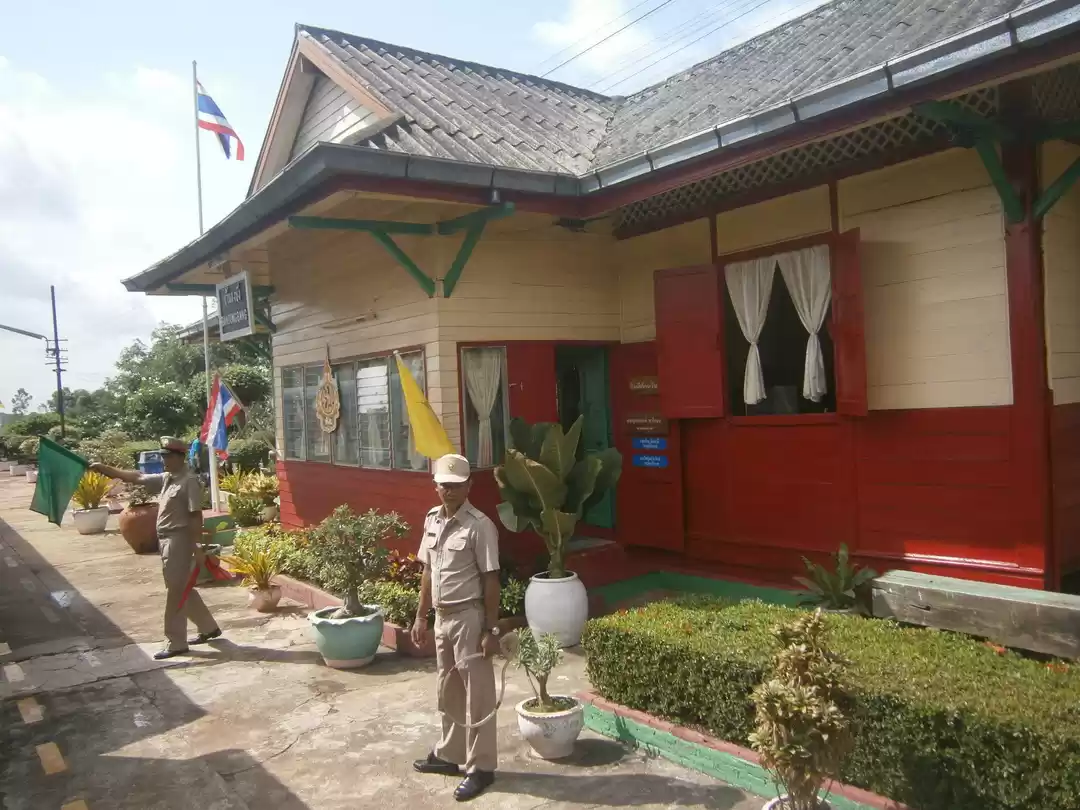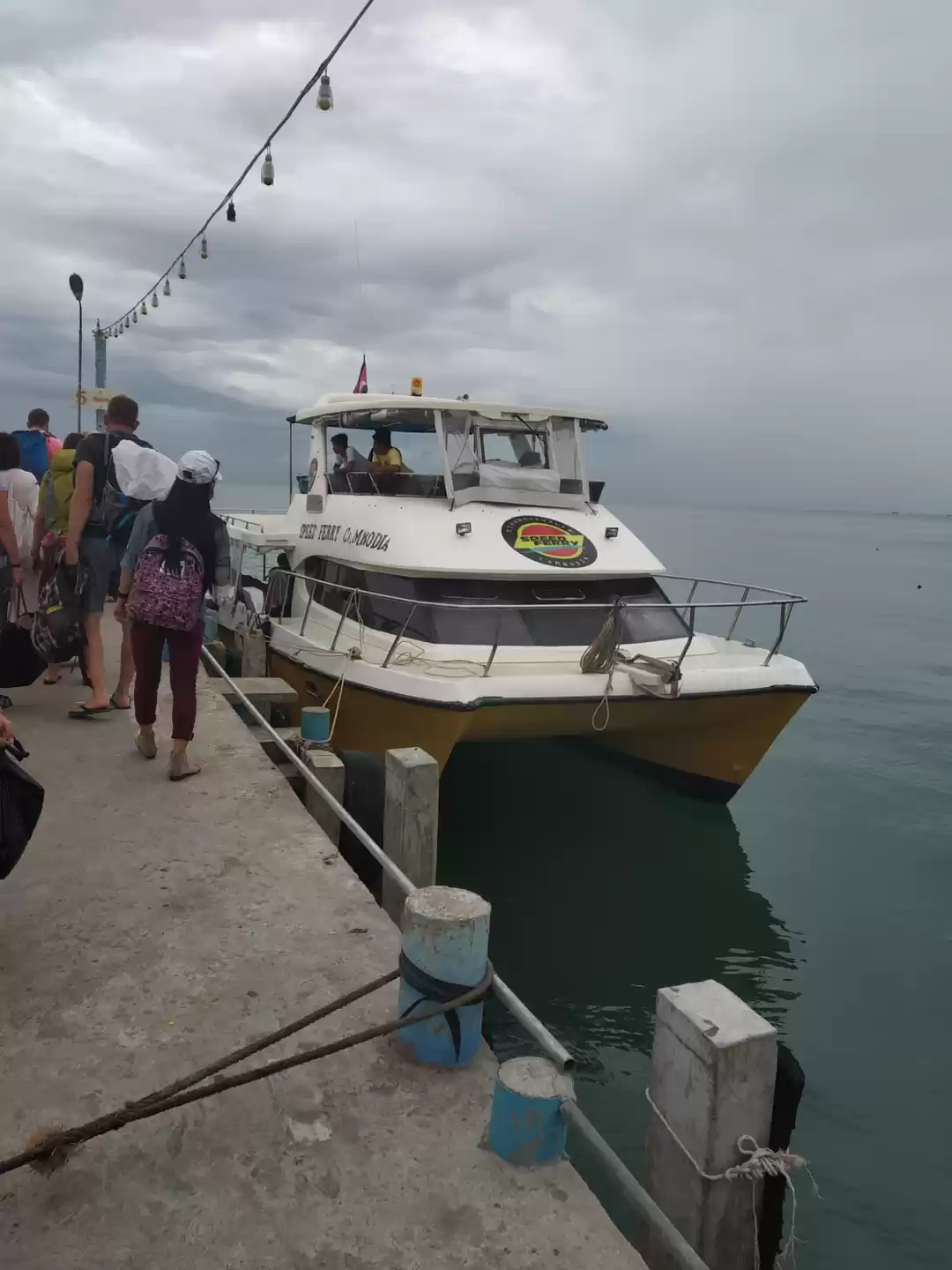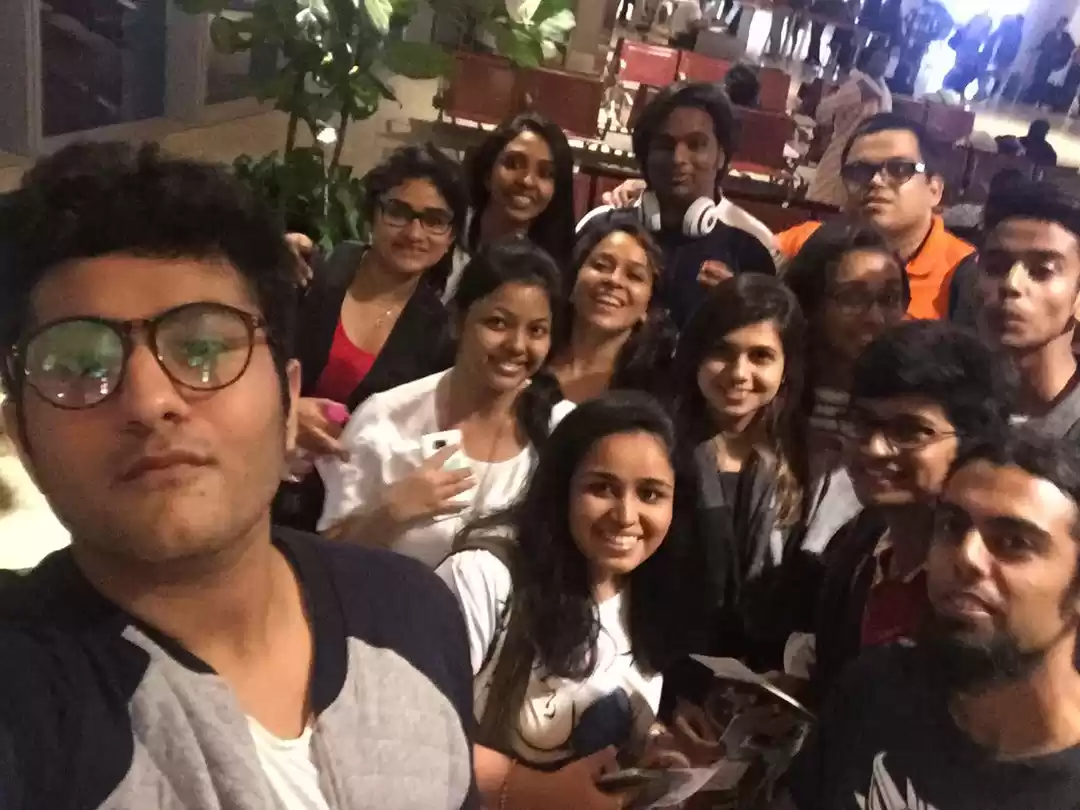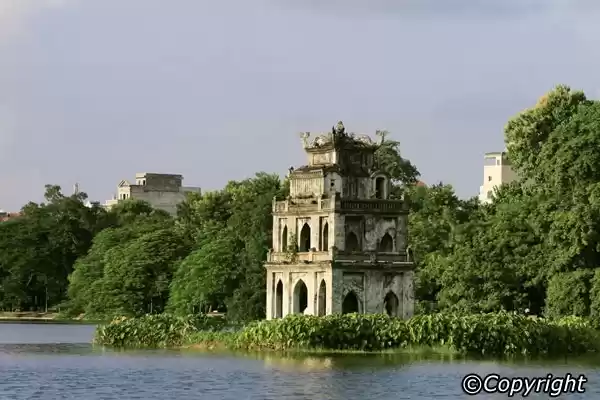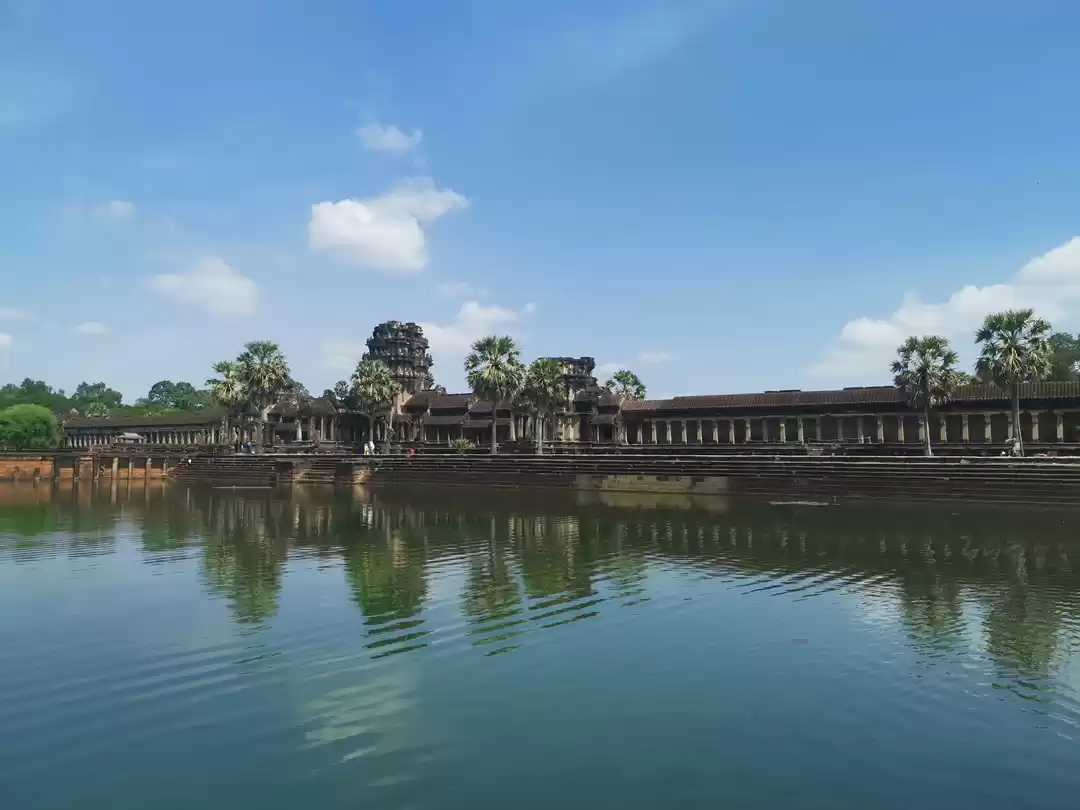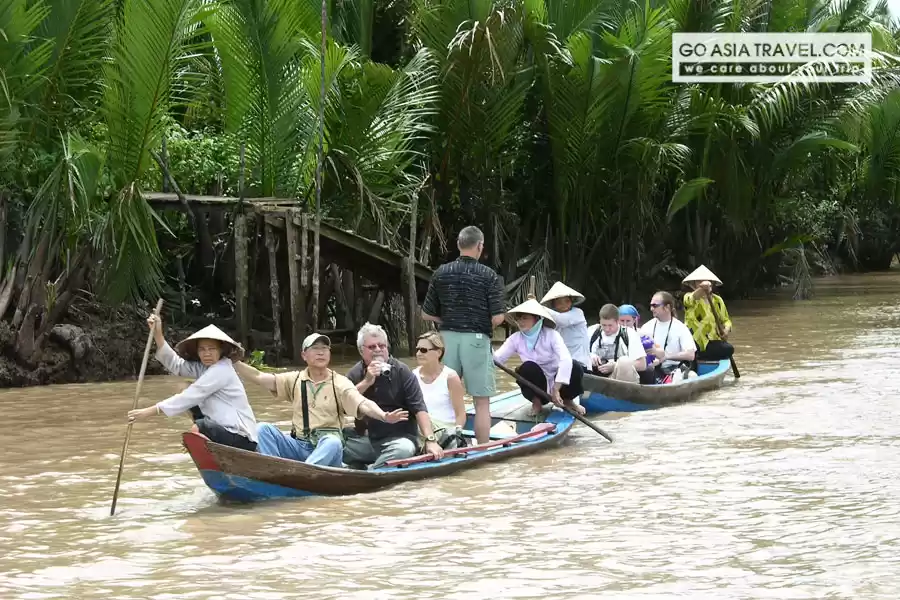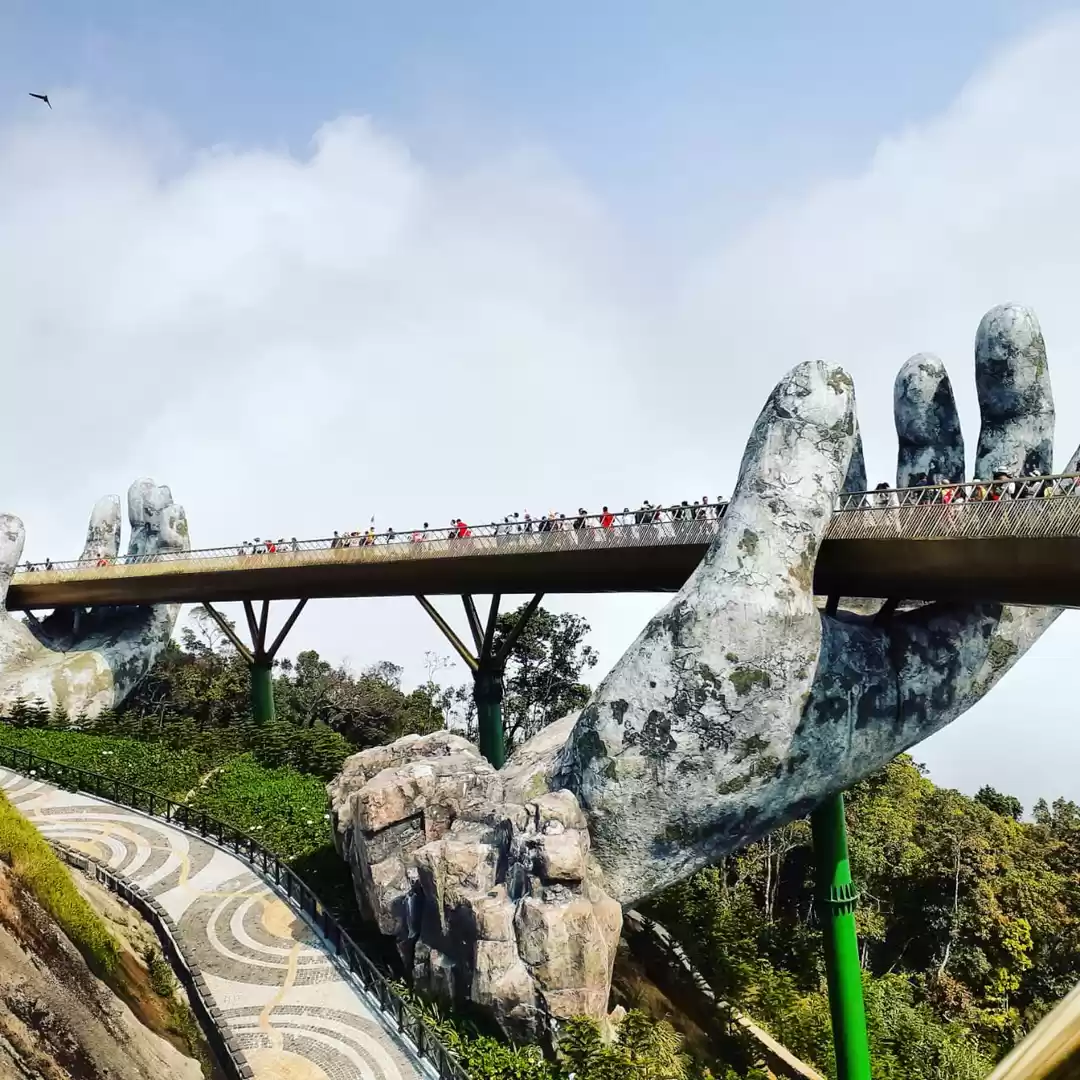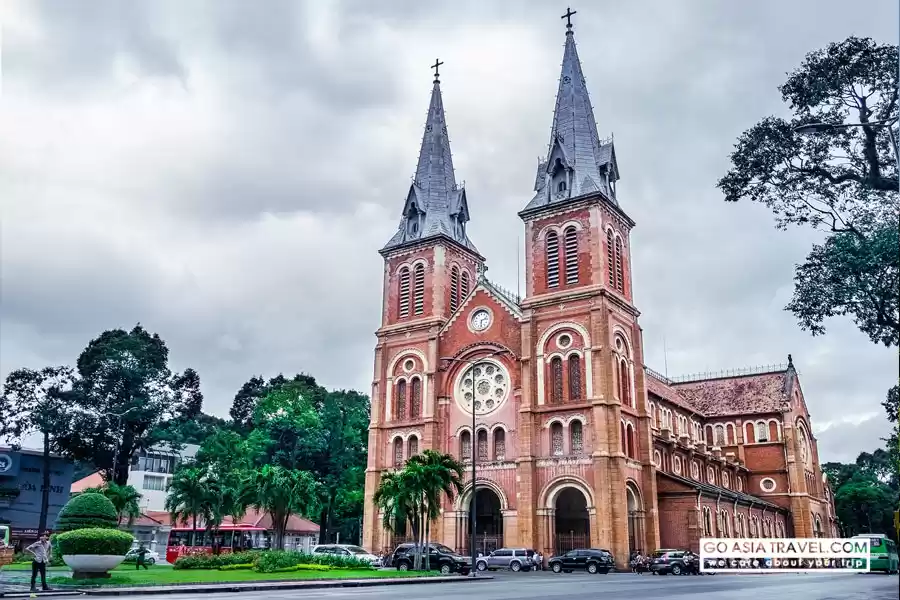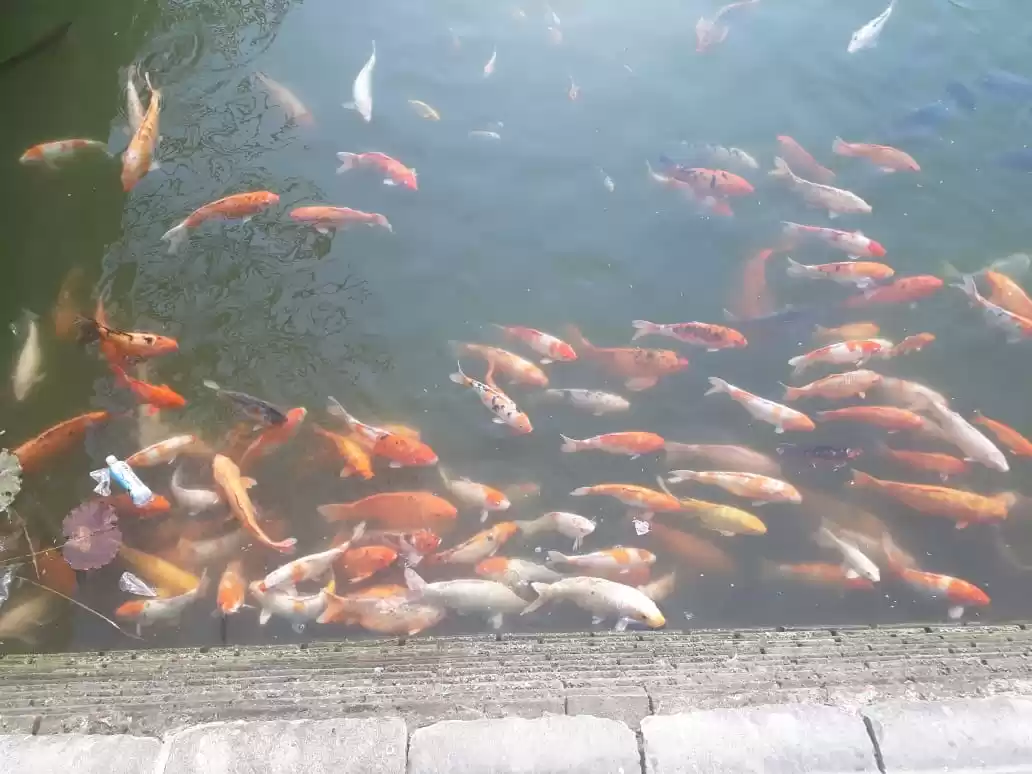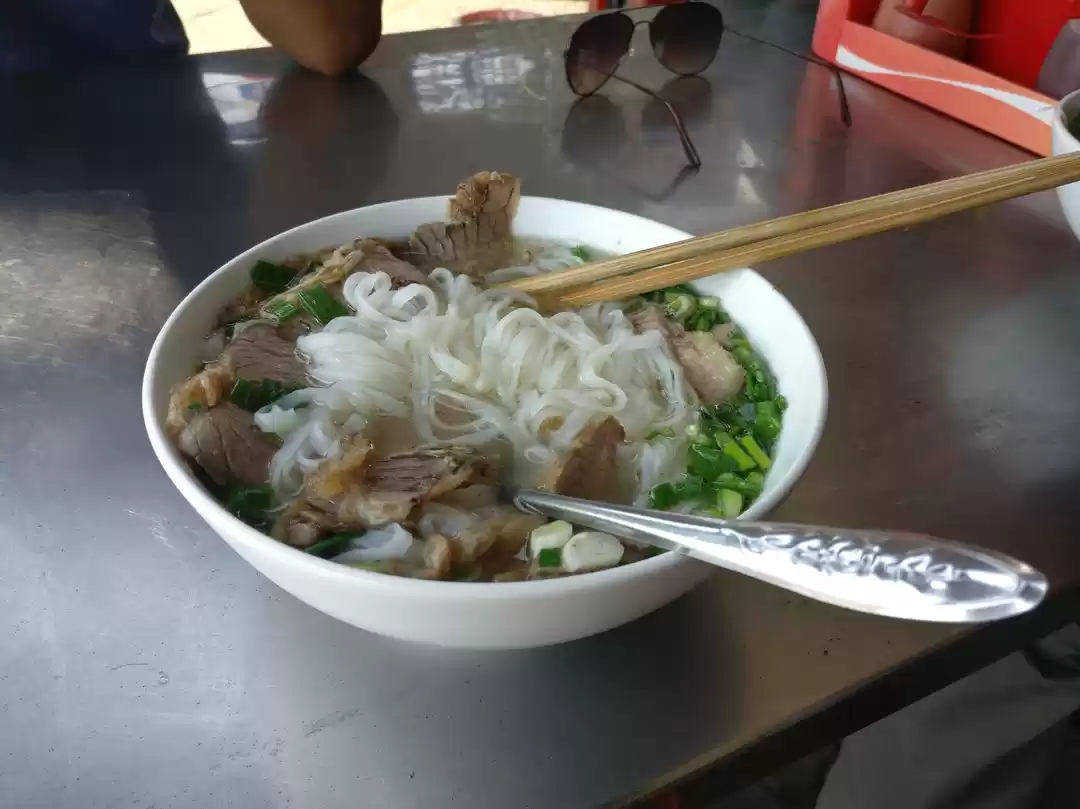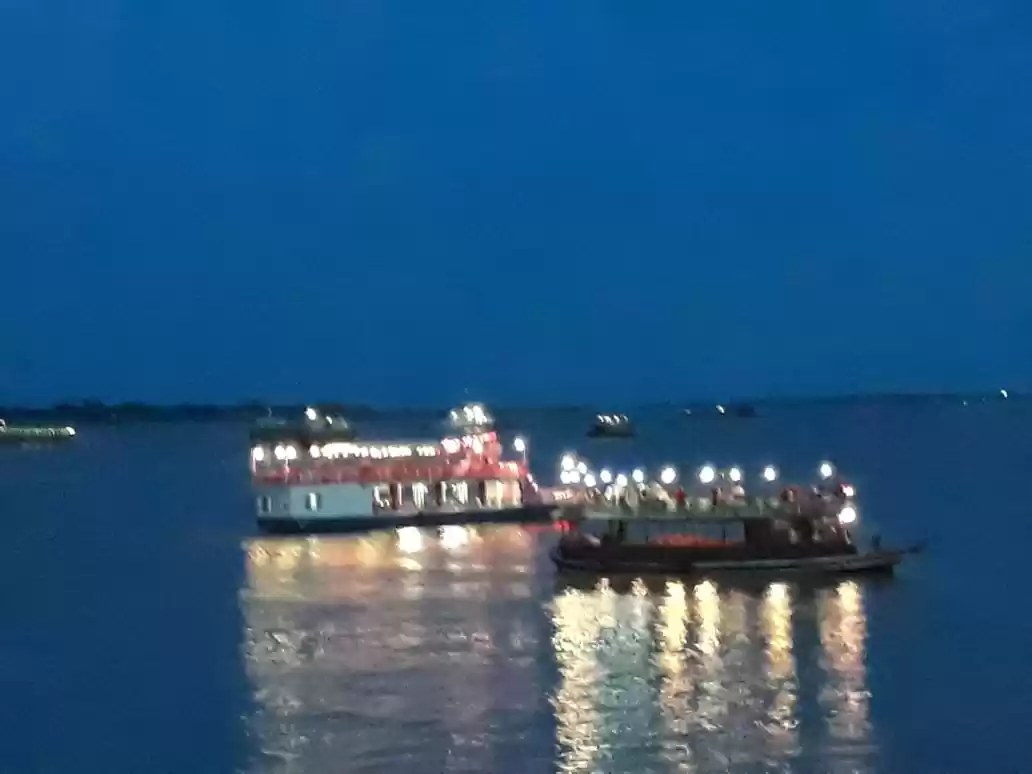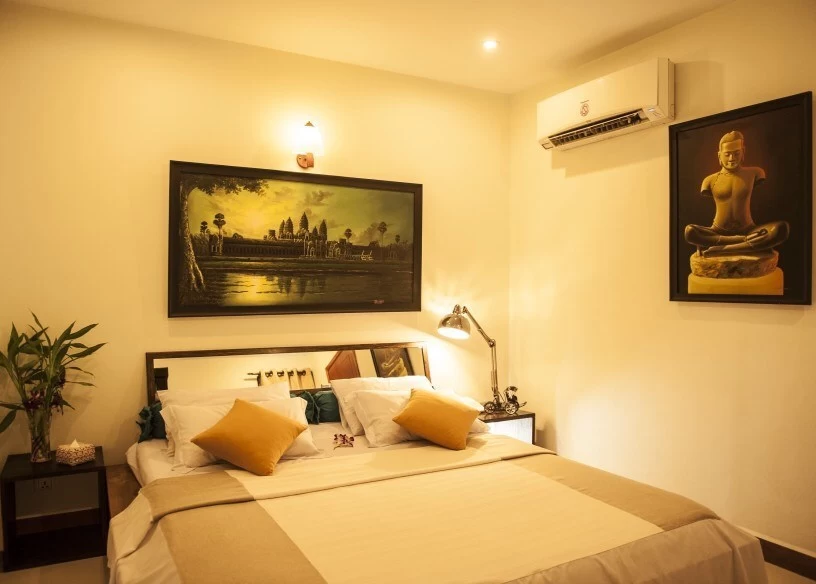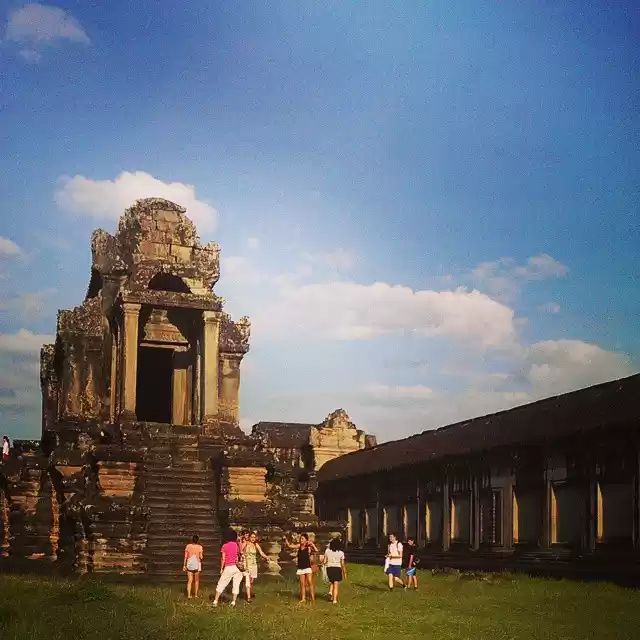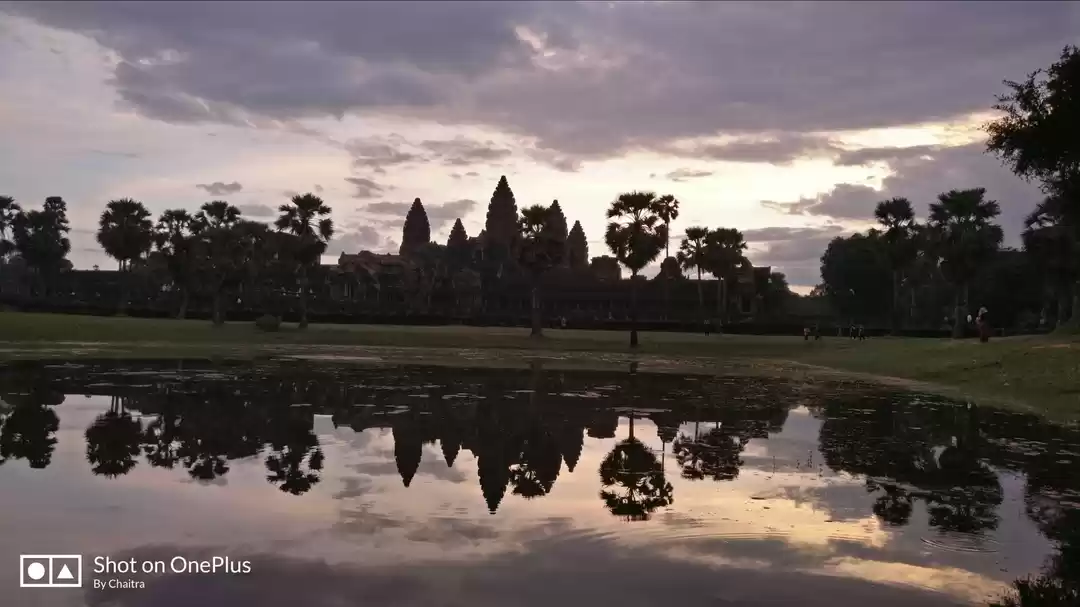
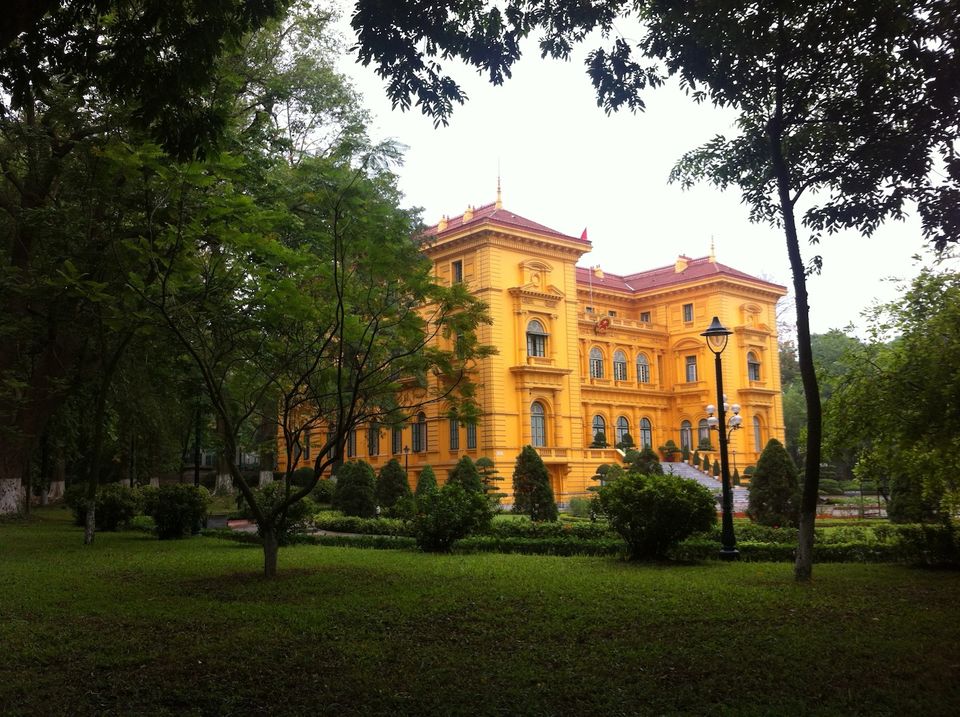
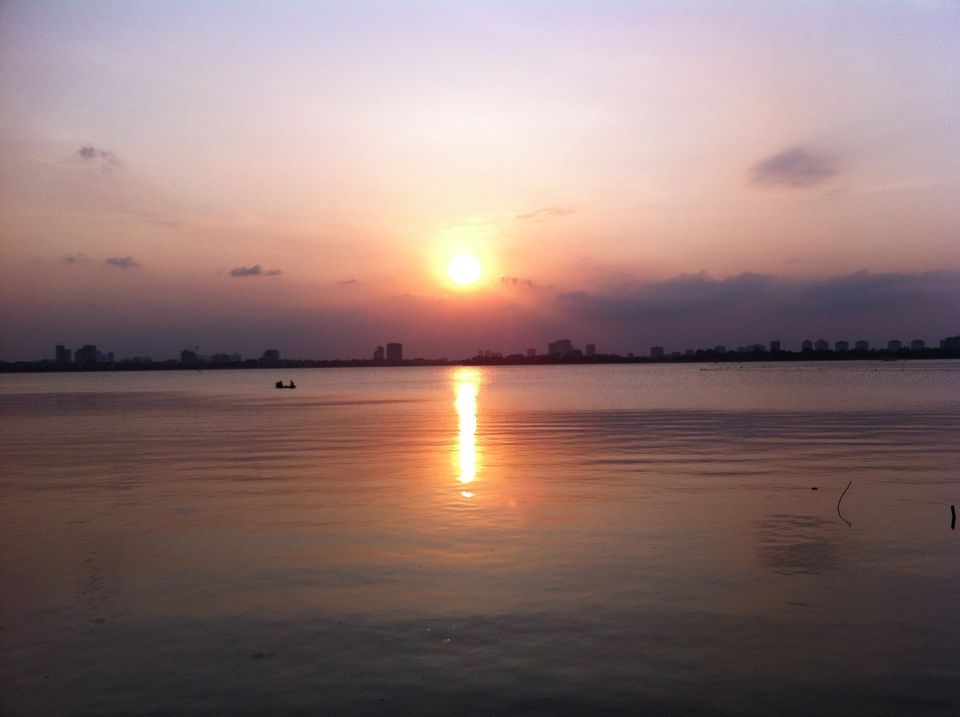
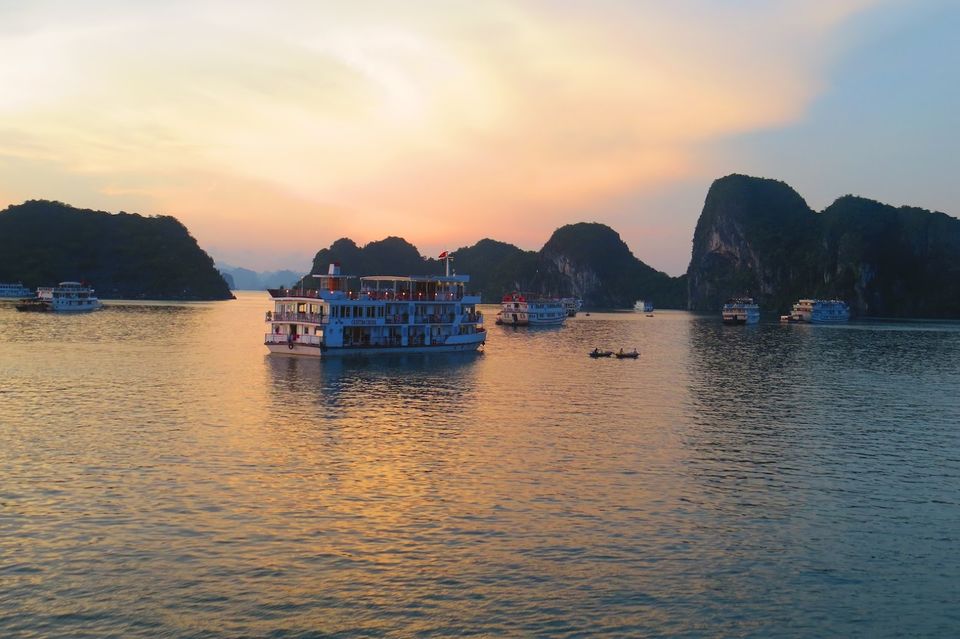
I had so many doubts before going to Vietnam regarding the food, language, people and weather. Was it really worth it? Aren't there better places to spend my ten days?I am so glad that I did go there, thanks to my friends who had already booked their flights for Hong Kong and wanted to take a trip together to a nearby country in South East Asia. Lovely cafes, buzzing markets, friendly people, great customer service at hotels, beautiful towns/coast and all within budget!
The cherry on top were the Angkor Wat temples in Cambodia. The temples are easily accessible from Ho Chi Minh City, so I would recommend everyone to combine these two destinations - Vietnam and Cambodia in a two week trip.
The two biggest cities in Vietnam are 1) Hanoi in North 2) Ho Chi Minh in South. The former is the administrative capital and the latter is the financial capital - somewhat like Delhi & Mumbai.Fly into Hanoi and make your way down south. From South Vietnam its easy to move onto Cambodia. In Vietnam we visited Hanoi - Ha Long Bay - Hoi An - Ho Chi Minh and Mekong Delta. After that I parted company with my friends and travelled alone to Cambodia. There I visited Phnom Penh and Siem Reap.
How to get a Visa :There are multiple websites where one can apply for Vietnam Visa online. These are run by authorized Vietnamese tourist agencies. After submitting the online application, the agency will mail you an approval letter. These sites charge a service fee ranging from USD 10- USD 25. I used www.vietnamvisapro.net . They charged USD 10 and provided the approval letter the very next day. On arrival at the airport - get in the queue of 'Visa on Arrival'. You need to show the approval letter and pay USD 45 to get the Visa on arrival stamped on your passport. Then you can proceed for immigration.Cambodia Visa is available on arrival and no prior online application is required. You can obtain visa either at the two international airports - Siem Reap & Phnom Penh or at the border checkpoints (in case you travel from Vietnam to Cambodia over land)
Which currency to take with you:Everyone in Vietnam accepts both Vietnamese Dong and USD. It is better to get your dollars exchanged for local currency when you arrive there as the USD prices applied will be a little unfavorable. One USD is approximately 21500 VND. Credit Cards are accepted at many places but sometimes there is a 3% surcharge applicable. In Cambodia , USD is the preferred currency. Everyone accepts dollars even the roadside fruit vendors. The ATMs dispense USD instead of the local Riel currency! The only time you'll deal in local currency is if you are transacting in units less than 1 USD. For some strange reason USD 2 note is not commonly accepted in Cambodia!
Where to book your stay:
You will see lots of these as you travel throughout Vietnam.After having lunch we took a cab to Temple of Literature. It was built in 11th century AD dedicated to Confucius. A few years later the site was expanded to house the first university of Vietnam. Hopeful candidates, in order to get accepted into the university, had to go through a multi-tiered process of clearing local, regional and national examinations. The names of the scholars who finally graduated are engraved on the tombstones above tortoise backs inside the university precinct. The university is now not functional. But we saw many student groups there. Apparently, if there are any important examinations, Vietnamese students come there to rub tortoise head for good luck.Next we took a cab to Hoa Lo Prison. The prison was built in 1890s by the French colonialists to hold Vietnamese criminals. Later Vietnamese used the prison to house American prisoners of war. The prison is now a museum , with exhibits telling stories of the Vietnamese communists who were imprisoned, tortured and murdered by the French. Then there are pictures of American Prisoners of War showing how well they were treated by the Vietnamese. As per Vietnamese, due to the nice treatment meted out, the Americans POW used to refer to the prison as "Hanoi Hilton". You'll read a different version on the internet - that American POWs had to go through severe torture in Hoa Lo and they sarcastically coined the nickname "Hanoi Hilton".We had initially planned to also see Old Quarter & Hoan Kiem Lake as part of the tour but because of the hot weather we decided to cut short our tour and head back to the hotel. In the evening we headed to the Weekend Night Market. It takes places every Friday -Sunday in evening in the old town. It turned out to the best place for souvenir shopping - but you have to bargain really hard. In the same street we found Hanoi Rocks Hostel. It had a big bar on the ground floor. After shopping it was nice to sit there and relax. Nice ambience, cheap drinks and decent food.Day 3 : Hanoi
Dong Xuang Market. Hang Dau Street Hang Gai street

















Hanoi : Best is to stay in the old town so that it is easy to walk around and explore.We stayed at Hanoi Symphony Hotel - a small boutique hotel with around 10 rooms. Excellent location, large rooms (our room had two double beds) , free WIFI and superb customer service. Breakfast was also included (limited options though). It was a steal at just Rs 2000 per night for a double room. Their laundry charges were also reasonable. The hotel far exceed our expectations. One person in our group forgot few of his clothes at this hotel. Later, while we were in Ho Chi Minh city, the hotel promptly couriered the clothes to him without any charges.
Ha Long Bay : There are many companies who offer Ha Long bay Cruise.After going through multiple reviews on the net, we finally booked an overnight cruise with Galaxy Premium Cruises and what a great decision it turned out to be. We paid $139/person which included the pickup/drop to our hotel in Hanoi, 1 night stay on the ship, all meals and kayaking. It is a small cruise ship with only 16 cabins with attached bathrooms. The rooms were pretty good. Their basic cabins and premium cabins all looked the same, only difference being that the premium cabins were on the upper floor. We had the best veg food of our trip during the cruise. They served a variety of non-smelly veg food , and didn't repeat a dish even once. The only complain from one person in our group was that the bed was too soft resulting in back pain.
Hoi An : It is a very small town, so wherever you stay it is unlikely that you'll be too far away from old town. We stayed at Hoi An Sun River Hotel. As the name suggests it is on the banks of Hoi An river. A boutique hotel with a small swimming pool and free bi-cycles. It is located about 2km from old town. We really enjoyed the river-view and cycling into the old town. Cabs were also easily available. Rooms were pretty with a lovely balcony. We paid Rs 3000 per night per room including breakfast. Friendly staff. The only complaint would be the patchy wifi.
Ho Chi Minh: Being the business hub, it is relatively one of the expensive cities in Vietnam. Try to stay in District 1 where most of the tourist attractions are. Traffic in HCM is terrible, so you don't want to spend too much of your time commuting. We stayed at Silverland Central Spa & Hotel - a small hotel in District 1. We couldn't have chosen a better location - walking distance to the main markets and close to all the sight-seeing. Big nice rooms although no balcony. Being part of a chain, the service in this hotel was less personal and it wasn't as good as other hotels that we had stayed in, but no major issues. It has a roof top bar - OMG - which seemed to be decently popular. We went there for dinner on our last night, and quiet liked it. We paid Rs 3800 per night per room including breakfast. Totally worth it considering the location and the amenities.
Phnom Penh : Cambodia's capital city has plethora of affordable boutique hotels. I stayed at Hotel Kabiki. It is well located - about a km walk to the Royal Palace and the Sisowath Quay. Also it is next to the Prime Minister's house , so the street is closed off to traffic and theres plenty of security around, making it one of the safest spots in the city.The property is very pretty with lots and lots of trees. Theres a swimming pool and a nice poolside cafe where they serve breakfast. The rooms are nicely done in earthy decor. The staff was very friendly. Tuktuks were available just outside the hotel. My only complaint was the AC - it wasn't very effective. I paid Rs 2700 per night including breakfast. Depending on your budget you can also look at other hotels from the same group - Blue Lime, The Plantation and The 240. All have great reviews on the net.
Siem Reap : This is purely a tourist town and as such has many hotel options. Best is to stay in the city centre near pub street /Angkor night Market where you'll most probably be spending your evenings after a day of temple sight-seeing. Angkor temples are about 10km from Siem Reap city centre. It is better to stay in city centre than near the temples. For the temples you'll most probably be taking a guided tour which includes hotel pick up. I stayed at Bayon Boutique Hotel. Huge and well done up rooms. Big enough to fit in 4 people ! It had a small swimming pool and a movie room where they show a movie about Cambodia everyday at 7pm. Ankgor Night market and pub street both were just a short stroll away. I paid Rs 2700 per night including breakfast and complimentary airport pick up. They also offered me free mini-bar . I couldn't clearly understand why , something to do with the fact that I had booked through Expedia I think. Here's our itinerary :
Day 1: Hanoi
Fly into Hanoi, get your Visa on arrival and take a taxi to your hotel. If you are staying in the old town (the main tourist area), the taxi will cost approximately USD 20 or VND 400,000. At the airport I picked up the Mobifone tourist SIM card for VND 200,000. It provided 1.5GB of 3G internet and 50 minutes of local calling, with 30 days validity. You should tell your requirement (internet/calling) upfront to the shopkeeper so they can activate the necessary plan on your SIM, else your balance will get consumed quickly at a higher rate.With half day in hand, we explored the old town area around our hotel.
We walked to the Hoan Siem Lake and took a full round around it. Its a lovely area with nice cafes/restaurants/ souvenir shops. Along the sidewalks there were a number of tea stalls withe small stools - this seemed to be a quintessential Hanoi feature. These also serve Pho - a Vietnamese noodle soup with beef or chicken. Its a popular food there for breakfast and occasionally lunch. We enquired about a veg version - but that for them was soup without meat but with chicken broth! Beer lovers should try 'Bia Hoi' or 'Fresh Beer' very popular in Vietnam , but more so in Hanoi. The beer freshly made every day and guzzled down by the time bars close down at night. No preservatives added.
A Bia Hoi joint is easy to spot -just look out for small blue and red stools spilling out on the footpath and streets.Hanoi streets are full of two wheelers. With a population of 7 million, the city has around 5 million bikes. Relatively the number of cars are much lesser. We found out later, during one of our tours,that the cheapest car in Vietnam costs USD 20,000 due to heavy import duties . Even with lesser number of four-wheelers, there was enough traffic to make crossing roads an adventure. The oncoming vehicles wouldn't even slow down a fraction.
Day 2 : Hanoi
Our two guides met us at our hotel promptly at 8am. First we took a cab to Ho Chi Minh Complex which includes HCM Mausoleum, President's Palace and HCM's quarter. We skipped going inside HCM Mausoleum as the queue there was unbelievably long, longer than what I have seen outside Eiffel Tower and Colosseum ! A huge number of Vietnamese visit the Mausoleum to pay their respects to 'Uncle Ho' , as they refer to HCM. Their regard for the leader is such as for one's own family. Interestingly, Ho Chi Minh in his will had written that he wants to be cremated after death, but the Vietnamese people decided to mummify him, on display today inside the Mausoleum.
Next we walked to One Pillar Pagoda situated very close to HCM Complex. The temple is dedicated to Goddess of Mercy. Vietnamese go there to pray for a child, especially a male child ! As per what we learned from our guides, an average Vietnamese has 2-3 children, and sometime more in quest of a male child.
We took a cab to Museum of Ethnology, my favorite part of the tour. The museum gives insights into different ethnic groups of Vietnam . There are full scale replicas of various type of Vietnamese homes. Some of the tribes were matriarchal with fascinating traditions. Inside Vietnamese homes, there is usually an altar, to pray to the ancestors, located in a prominent place. Outside most of the houses, there is a spirits house to guard against the evil.
You will see lots of these as you travel throughout Vietnam.After having lunch we took a cab to Temple of Literature. It was built in 11th century AD dedicated to Confucius. A few years later the site was expanded to house the first university of Vietnam. Hopeful candidates, in order to get accepted into the university, had to go through a multi-tiered process of clearing local, regional and national examinations. The names of the scholars who finally graduated are engraved on the tombstones above tortoise backs inside the university precinct. The university is now not functional. But we saw many student groups there. Apparently, if there are any important examinations, Vietnamese students come there to rub tortoise head for good luck.
Next we took a cab to Hoa Lo Prison. The prison was built in 1890s by the French colonialists to hold Vietnamese criminals. Later Vietnamese used the prison to house American prisoners of war. The prison is now a museum , with exhibits telling stories of the Vietnamese communists who were imprisoned, tortured and murdered by the French. Then there are pictures of American Prisoners of War showing how well they were treated by the Vietnamese. As per Vietnamese, due to the nice treatment meted out, the Americans POW used to refer to the prison as "Hanoi Hilton". You'll read a different version on the internet - that American POWs had to go through severe torture in Hoa Lo and they sarcastically coined the nickname "Hanoi Hilton".
We had initially planned to also see Old Quarter & Hoan Kiem Lake as part of the tour but because of the hot weather we decided to cut short our tour and head back to the hotel. In the evening we headed to the Weekend Night Market. It takes places every Friday -Sunday in evening in the old town. It turned out to the best place for souvenir shopping - but you have to bargain really hard. In the same street we found Hanoi Rocks Hostel. It had a big bar on the ground floor. After shopping it was nice to sit there and relax. Nice ambience, cheap drinks and decent food
Day 3 : Hanoi
Dong Xuang Market.Hang Dau StreetHang Gai street
Around 5pm we took a cab toWest lake, the largest freshwater lake in Hanoi. There are many historic places of interest around the lake including the oldest Vietnamwese Pagoda and one of their sacred temples. Some of the biggest hotels in the city are also located near the lake. We walked a bit around the lake and then settled at a small cafe to enjoy the sunset. After the sunset we walked a bit more and went into a small pub called 'Red River' . It had a unique concept of serving only drinks while one can order food from other nearby restaurants. They provided menus of different restaurants to us. After dinner we headed back to the hotel for an early night as we had a early start the next day.
Day 4: Ha Long Bay
The cruise company minivan picked us from our hotel at 8am and at their office we transferred to a big bus. It was a four hour bus ride to Ha Long Bay. Our guide was Mr. Dat - he said we could also call him Peter (his English name kept for the benefit of tourists) or Success (meaning of his Vietnamese name apparently). A really cheerful guy who kept us entertained with information about Vietnamese history and its culture. On the way we stopped for a half hour break at a tourist service centre.
We arrived at Hon Gai pier at around noon and then transferred to the cruise ship. After we checked in, we were served lunch. We were pleasantly surprised with the wide variety of veg food. Some time after lunch we reached Cat Ba national Park area where we got off for kayaking and swimming. After getting back to the ship we cruised to the overnight anchorage. Scenery along the way is simply breathtaking. In the evening there was a spring roll cooking class. After the class we made our way to to the top deck to enjoy the fantastic sunset. At night some of us tried squid fishing, only a couple of guys were lucky enough to catch some.
Day 5 : Ha Long Bay
Next day we got up early for a Tai Chi class at 6:30am. Breakfast was served at 7am. After the amazing vegetarian food the previous day, breakfast was a let down with hardly any edible veg options. At 8am we transferred to a small boat to visit Sung Sot Cave. After spending an hour there, we came back to the ship , freshened up and checked out of our rooms by 9:30am. At 11am the lunch was served.
Second day was somewhat rushed - my only complaint about the cruise. But I guess they had no option as the next group was to come on aboard at noon. At 12 we disembarked, got on a bus and headed back to Hanoi. We reached Hanoi Symphony Hotel at around 4:30pm.In the evening we made our way to Thang Long Water Puppet Theatre. Water puppetry is a traditional art form of Vietnamese. The theatre is located near the Hoan Kiem Lake. Everyday they have five shows - of one hour each. The ticket is priced at around USD 5. There are 10-12 performances showcasing local culture and customs. There is an orchestra which plays typical Vietnamese musical instruments. The singing is in Vietnamese language but they provide a brochure with explanations - quiet helpful. There are four sacred animals in Vietnam - Turtle, Dragon, Unicorn and Phoenix. Most of the Vietnamese outside the big cities are engaged in fishing and agriculture. The performances show all these aspects and more. The story of Hoan Kiem Lake is also told in one of the performances.
Day 6: Hoi An
Early morning we flew to our next destination. There is no airport in Hoi An. One has to fly to Da Nang, a coastal city about 20km from Hoi An. We used VietJet Air, a low cost airline. The tickets cost around Rs 3000 per person. We had booked an airport pickup through our Hoi An Hotel - it cost us only USD 20 in all.
From the aircraft Da Nang looks stunning with a gorgeous coastline and small hills. A little bit of the city that we saw, as we passed through it, really impressed us. It looked as modern as any city in the West - shining new-looking white buildings, dwide roads, and absolutely no dust. It is apparently being developed as a leading urban centre in the country. Hoi An Sun River hotel was a delight. We settled in and headed for lunch to Karma Waters, a vegan restaurant. The big draw for us was that it served a few Indian dishes. This restaurant has really good reviews on tripadvisor but we found the food disappointing. There was no salt, no spices at all in the food. This actually is applicable to most of Vietnamese food - no salt , no sugar. Not surprising that the Vietnamese look extremely fit.Back to our hotel, we had some local Vietnamese wine - Vang Dalat. A bottle costs about USD 5. During our trip we tried both red and white variety of Dalat wine. Both were very mild, and tasted ok. White wine had a lime juice like flavour. The red was sweet, it was made from cardinal grapes with mulberry juice added. If you are the adventurous type, you can try Vietnamese Snake Wine. It has whole snakes infused in rice wine! Commonly available in tourist markets in Vietnam.
After resting for some time at the hotel, we took a cab to An Bang Beach, about 5km from Hoi An. It seemed like everyone in Hoi An has descended there. Considering the low season and how small the town is had not expected to see such huge crowds. It is a mystery how the beach was still so clean. Unless you are really keen on beaches, would recommend tourists to avoid An Bang.
Late evening, we cycled to the Hoi An Ancient town to check out the Night Market. The old town is simply enchanting with its timber frame yellow buildings. A river passes through the town and there are beautifully lit up houses/cafes on both sides of the river. The Night Market was mostly selling souvenirs, and jewelry. There was a row of shops selling silk lanterns that Hoi An is famous for. The whole atmosphere feels magical.We then had dinner in one of the restaurants along the river. We gave some complex instructions to the waiter about how to prepare our food. He thankfully followed them to the t and for a change we enjoyed spicy yummy veg food.
Day 7: Hoi An
Hoi An used to be a major port city in 17th & 18th century and today is deemed a UNESCO World Heritage site. We had booked a half day Hoi An city tour with 'Hoi An Food Tour' company. The charges were USD 27 per person including guide, entrance fee, and transfers. Our guide picked us up from the hotel at 8am.
After purchasing the entry ticket to the ancient town, we walked to Phuc Kien Temple - it was built by the Chinese in 17th century as an Assembly Hall but later converted into a temple dedicated to the goddess of sea who protects sailors. It is a photogenic monument with ornate gate and colorful courtyard.
Next we visited couple of ancient houses - Tan Ky Ancient House and Phung Hung Ancient House. Tan Ky was built around two hundred years ago as home of a Vietnamese merchant. It is a well preserved house with the original interiors and furniture kept almost intact. Phung Hung is a two-storied house built in 18th century. The house has kept many old documents and handicrafts reflecting the culture and tradition of Vietnam. The architecture of both the houses reflects influence of three cultures- Japanese, Chinese and Vietnamese.
Japanese Bridge is the most famous symbol of Hoi An. It was built in 16th century by Japanese community to create a link with the Chinese on the other side of the stream. It is a covered bridge and inside there is a temple dedicated to God of Weather. The bridge is quiet beautiful and should not be missed on a trip to Hoi An.We then visited a couple of cultural showrooms showcasing local embroidery work and silkworm breeding.
Our last stop was central market - it is an authentic market visited by both locals and tourists. On sale is more of regular stuff like grocery, utensils, spices, fruits/vegetables , fish etc. There were a number of small stalls there , all pushing there wares on us quiet hard. We were glad of our guide's help - she helped us buy Vietnamese Coffee, coffee filter and rice paper (used for making Vietnamese spring rolls), all at a very reasonable price. Hoi An is known for its fine tailoring. There are a number of tailors who can make custom tailored suits, dresses, shirts etc.
Our guide took us to Hoang Dieu Street where there were many such tailor shops. My friends ordered couple of dresses and a suit, all stitched and handed over by end of the same day. The street also had a money changer offering the best rate we had got so far in Vietnam .We reached back at the hotel at 11am. I felt that in Hoi An a guide is not required for sight-seeing. One can easily explore the town independently on foot or bi-cycle. More than visiting the landmarks, the town is about enjoying its picturesque streets and charming architecture.
After lunch we cycled back to the ancient town riverside area. We walked on both sides of the river exploring shops and enjoying the crowds. While standing on the bridge we saw some couples on boats, floating candles in the river. They seemed to be in their wedding clothes, with a team taking their pictures.While we were looking for a place to sit down for a drink, we stumbled upon Mango Rooms. It turned out to be one of the best restaurants on our trip. We had no plans to eat but the restaurant served us a complimentary vegetarian tempura which tasted so good that we ended up ordering lot of other vegetarian stuff - all of which was excellent.We really loved Hoi An and wished we could have spent an extra day there.
Day 8: Ho Chi Minh City (Cu-Chi Tunnels Tour)
Early next morning we took VietJet Air flight from Da Nang to Ho Chi Minh. Ho Chi Minh City is informally called Saigon, after the Saigon river flowing through the city. We arrived in HCM at around 10:30am, got picked up at the airport by the hotel cab, and straightaway went to Cu-Chi Tunnels. One has option to book a half day Cu -Chi Tunnels tour which usually includes pick up/drop from hotel, transfer to the Tunnels, entrance fee and a guide.
There are both bus group tours and private tours available. Other option is to do the tunnels independently as along with the entrance ticket an english speaking guide is provided. We didn't want to do a big bus tour and private tours were working out to be expensive. So we decided to do it independently. We just booked a cab with our hotel to pick us up from airport, take us to the tunnels, and then drop us back to the hotel (our hotel check in was anyway at 2pm so we had time on our hands).The Tunnels are located 80km from HCM , and it took us two hours to reach there. Entry fee is USD 4.5 including a guide.
Cu-Chi Tunnels played a very important part in American-Vietnam War. The tunnels, stretching more than 120 miles, were originally built in 1948 to hide from French air attacks. Later during the American War, these tunnels were used to ambush troops, move supplies and even as living quarters. They house underground dorms, kitchen, dispensary, storage facilities etc.
During the tour we were shown many on the booby traps set up by VietCong (Vietnamese communist army) during the war. To experience the life of guerillas, we took a short walk inside one of the tunnels. Despite the fact that tunnels have been expanded to accommodate the tourists, they still felt too narrow and low ! It was huge relief to come out on the other side. Totally amazing how the Vietnamese managed to live in those tunnels for years !Within the Cu-Chi tunnels complex, there is also a firing range where you get to shoot rare guns like AK47 and M16. Shooting charges are extra and the pricing is by the bullet.
At the end of the tour we enjoyed a treat of tapioca and Vietnamese tea, the main staple food during the war.The whole tour took about 2 hours. We reached back at the hotel at 5pm. Evening we visited a local market with some Indian friends living in HCM. Taka Plaza was a covered market mostly selling clothes - huge variety, decent quality and reasonable prices. Our friends then took us to a standalone store Thuy Trang - a shoe haven. Have never seen so many varieties under one roof.For dinner we went to 'Hum' - a very popular vegan restaurant in HCM. Lovely ambience and awesome drinks. The drinks serving style was unique. We tried many Vietnamese veg dishes and all were good. Would highly recommend anyone visiting HCM to try this place. Its pricey for Vietnam but comparable to a fine dining restaurant in Mumbai.
Day 9: Ho Chi Minh City
We had booked a full day tour with Saigon Hotpot, again a volunteer tour guide club. The guides were a bit of a disappointment - it was difficult to understand their accent, and they were not able to provide very clear information.
With them we visited Notre Dam Cathedral, Central Post Office, Reunification Palace, War Remnants Museum, Jade Emperor Pagoda, City Hall and Opera House. All located in downtown in District 1. We first took a cab to Notre Dam Cathedral , a km away from our hotel. It was built in 19th century by French colonialists. The interiors of the basilica do look a bit similar to its namesake in Paris but is not as ornate. In front of the cathedral there is a Virgin Mary statue which is said to have shed tears in 2005 causing thousands of people to stop at the basilica. As per our guides, later it was discovered that there is a small hole on the top of the statue, and some rain water must have passed down coming out through the eyes. Across the street from the cathedral lies the Central Post Office, the largest PO in Vietnam. The building looks beautiful from outside. Its architect is the famous Gustav Eiffel who also designed Eiffel Tower and Statue of Liberty.
The cathedral - post office area seemed to be popular for taking wedding photos. We saw at least four wedding couples getting their photos professionally clicked over there. The boulevard outside the cathedral is quiet picturesque and a popular walking street. We decided to come back there later in evening.Walking distance from post office is the Opera House, another city landmark built by the French. It is open to the public during events/shows. Next our guides took us to a road-side kiosk to try Vietnamese milk tea. They had a wide variety of flavours, mostly fruit based, served both hot and cold. All four of us tried different flavours and they all tasted amazing.
We then took a cab to War Remnants Museum. Few museums drive home the brutality of war so effectively. There are disturbing photographs of US war atrociwties. The are photos and news clipping showing how widely the war was opposed within US and by the world. It is unbelievable that this war continued for more than 20 years, under four different US Presidents. A section displays pictures of children horribly effected by Agent Orange, a bio-chemical used by US during the war. You will also see some of these effected Vietnamese in person, selling handmade souvenirs inside the museum. The museum closes by 12 noon, so reach there early enough to be able to go through most of the exhibits. Entry fee is 15,000 VND.
From War Remnants Museum we walked to Reunification Palace or the Independence Palace. Originally it was built as residence for French Governor General. Later, when Vietnam was split into North Vietnam and South Vietnam, the building served as the presidential home for South Vietnam's President. On April 30th, 1975, North Vietnamese tanks crashed the gates and took over the palace. Vietnam became one country again in 1975, and since then palace is referred to as Reunification Palace. Entrance fee is VND 20,000. While its an important historic symbol for Vietnam, the building itself looks unimpressive.
Next we took a cab to Jade Emperor Pagoda or Phuoc Hai Tu Pagoda. It is a Taoist Pagoda built by the Cantonese Chinese community in 1909. The temple is dedicated to many Buddhist and Taoist Gods, most important being Jade Emperor, the Supreme of Taoist God. If you are going without a guide, do read up on it before visiting. There are multiple sections signifying various aspects of Chinese beliefs and rituals. There is a small hall with statue of Chief of Hell. Another room contains 12 women figures , each figure representing a year in Chinese astrological calendar. There is another hall containing statue of goddess of Mercy. As part of the tour, we had the option of visiting local markets with our guides but we decided to do those on our own. We finished the tour at 2pm.
After resting for some time we went to Benh Than Market located right next to our hotel. It is a huge covered market where you can find anything -clothes , footwear, food , souvenirs , handicrafts, electronics etc. You need to use your bargaining skills to the fullest. There is a small section with fixed priced shops, which I much preferred. Around 6pm, the shops closes down, and stalls get set up on the surrounding streets. We then visited an Indian friend's house in District 3. District 3 is the expat colony in HCM with beautiful villas and modern high-rise residential buildings. From there we headed to Opera house to catch the 8pm AO show. It is a one hour performance with a mix of acrobatic acts and theatrics. There are no vocals, only music and dance acts presenting Vietnamese culture in a contemporary manner. The cheapest ticket was for 500,000 VND. You can book online or buy on spot. Better to book online in advance to get better seats.After the show, we again went back to the Ben Thanh Market, this time to see the night version of it as a street market.
Day 10: Mekong Delta Tour
Mekong Delta lies in south-west Vietnam , where Mekong river empties into the sea through a network of tributaries. It is one of the most densely populated region in Vietnam and also one of the most productive region in terms of agriculture and fishing. The region produces almost half of Vietnam's agricultural output. Life there revolves around the mekong river - restaurants , houses, even markets float on the various streams and canals.
We had booked the tour through Galaxy Premium Cruises, and they in turn had tied up with TNK Travels. We found later that it would have been cheaper to book directly with TNK - they charge only USD 10 for this day tour. We were picked up from our hotel at 8am (pick up charges were extra). This was a big bus tour, and it took a lot of time for the agency to pick up/assemble everyone. We left Ho Chi Minh around 9:30am. It took us 2.5 hours to reach My Tho, a port city in Mekong Delta. We got onto a cruise boat on the Mekong River.
First stop was an island with tropical gardens where we sampled some season fruits and honey tea and listened to Vietnamese folk music. On the next island we visited a family business producing coconut candy. Next we got on to small rowing boats which took us deeper into the canals. For lunch we hit Tortoise island with vast fruit orchards. Lunch was quiet basic but then considering the tour price one cannot expect more. After lunch we hopped back on the cruise boat and headed back to My Tho. After arriving at My Tho, we visited Vin Thrang Pagoda - frankly it could have been skipped altogether.The tour was a rush job, simple hopping from one island to another. Though considering the tour price, its probably unfair to expect more. The experience may have been better in a small tour group when you can explore the region at own pace.We were back at the hotel by 5:30pm. Evening we went to OMG - the rooftop bar of our hotel to enjoy dinner along with city views.Day 11: Travel to Phnom Penh
Early next morning I took Giant Ibis bus to Phnom Penh. The bus station was just a km away from from my hotel. Giant Ibis is by far the best bus company for travel to and within Cambodia - comfortable seats, charging sockets, free wifi , complimentary water, snack and beverages. I booked tickets in advance on www.giantibis.com for USD 19.In 2 hours we reached Vietnam-Cambodia border. Cambodia tourist Visa on arrival costs USD 30.
Additional USD 5 was charged by the bus company for helping with Visa process. After going through the whole thing, I think the extra charges are well worth it. First we got off at Vietnam border for immigration which took about half an hour. There was total confusion at the immigration point with people trying to figure out in which queues they have to stand in. Thankfully for us, Giant Ibis took passports of all the passengers and got the necessary stamping done. We just had to cross over as and when our name was called out.We got back on the bus, and made a short trip across no man's land to reach Cambodia border check point. Here we were left at a restaurant for half an hour to have lunch, in the meanwhile the bus agency arranged for our Visas.
After another short bus ride we got off for Cambodia immigration which was fairly quick. My co-passenger on the bus was a Swiss national who had been living in Vietnam-Cambodia for last ten years. He was a mine of information about the two countries, their culture and politics. Like the fact that most of South Vietnam used to be part of Cambodia at one time. Even today many Khmer ethnic groups are living in the Vietnam Mekong Delta region.We reached Phnom Penh in 6.5 hours as per schedule. I had booked a taxi pick up from the hotel. I realised I could have managed easily on my own - the hotel was just 2km from the bus station and tuktuks were easily available. As had been suggested by the Swiss co-traveller, I asked my cab driver to take the river-side road, and stop at SMART Mobile outlet to pick up a Cambodia SIM. Priced at USD 5 , it provided 1.5 GB of 4G/3G internet. Call and SMS rates were very reasonable - just 4 cents/minute for international calling.
Check in at Hotel Kabiki was smooth. They provided a tourist map and helpful information on what to see. After resting for a couple of hours at the hotel I made my way towards Independence monument and from there towards Royal Palace. The palace was nicely lit up. Cambodia still has a king, but he has no political powers. Monks sitting on the grounds outside the palace made a pretty picture. From there I moved to Sisowath Quay - a 3 km boulevard along the Mekong river. The river-side road is full of restaurants, cafes, hotels, shops, and money changers. Most of the landmarks of Phnom Penh are accessible from Sisowath Quay.
As you walk along it, short detours will lead you to National Museum, Wat Ounalom, Wat Phnom, Central Market, Night Market. Lanes off the Sisowath quay have number of cafes, shops, grocery stores. From the boluevard, you can see the largest hotel of Cambodia - Hotel Sokha situated on the other side of the river.After exploring the area around the Sisowath Quoy, I had dinner at Sher-e-Punjab, an Indian restaurant located in a lane off the boulevard. Good food. As per reviews on the net and also as suggested by the Swiss traveller, it is one of the best Indian restaurants in Phnom Penh.
Day 12: Phnom Penh
After having an early breakfast, I left the hotel at 8am and hired a tuktuk to take me to Tuol Sleng Museum and Killing Fields. Killing Fields are located 15km from city centre. Tuktuks charge around USD15 for taking you from central Phnom Penh to Killing Fields, waiting there and coming back. The tuktuk driver agreed to include Tuol Sleng Museum, which is on the way, for the same price.
Museum entry fee is USD 2, and another USD 6 for a guide. I decided to do the museum on my own and was able to manage well based on the narrations provided. Tuol Sleng was originally a school converted into Pol Pot's secret prison during his rule from 1975-1979. Pol Pot's Khmer Rouge after taking control of Cambodia in 1975, emptied all cities (including Phnom Penh) within four days and forced the entire population to work in labour camps in countryside. People from nearby camps were brought to Tuol Sleng to be tortured, confess to their supposed crimes and finally sent to Killing Fields to be executed. It is estimated that around 11000-14000 people including 2000 children imprisoned in Tuol Sleng were executed. Inside different rooms of the building, you will see gruesome pictures and outside a few graves of the people who were imprisoned there.Interestingly there is an account of how a Swedish Delegation, in 1978, had visited Cambodia during Pol Pot's rule and basis the doctored version of what they were shown, the delegation gave a glowing account of Pol Pot's Democratic Kampuchea. They rubbished the horrific tales being told by Cambodian refugees. When Vietnam invaded Cambodia in 1979 (Cambodians refer to it is 'liberation day'), 7 adult and 4 child survivors were found in Tuol Sleng.
Killing Fields were the multiple sites in Cambodia where people were executed by Khmer Rouge. One such site is Killing Fields of Choeung Ek near Phnom Penh. The original sheds/building on the site have been destroyed. Today it is pretty much a large open field with a memorial. Entrance fee is USD 6 including an audio guide. Different sections are well sign posted and the audio guide provides chilling account of the techniques used by KR to execute men, women and children. These sites used to be surrounded by farms, and utmost care was taken to maintain secrecy of what was going on at the Killing Fields. Blind-folded prisoners where brought here in truck loads, with no idea of what was to happen.
At night, a loud speaker would play patriotic songs loudly so that screams of those executed could not be heard. KR believed in bludgeoning them with iron rods, axes, rocks rather than wasting a bullet.It is estimated that one in four Cambodians (2-2.5 million) died during Khmer Rouge. Those from other ethnicity, religion, intellectuals, artists, those seen as anti-establishment and their entire families were systematically executed. Almost every household suffered a loss. My own guide in Siem Reap lost his father and two brothers during KR.I exited the Killing Fields around 12 noon, and since there was still time for lunch, decided to make a short trip to Central Market.
This is the most popular tourist market in Phnom Penh . It is a covered market in city centre with a wide assortment of clothes, footwear, jewelry, paintings, food items, electronics and souvenirs. The stuff didn't much seem much different from that in Vietnam. After spending just an hour there I headed back to my hotel.Another popular market in Phnom Penh is the Russian Market.
I decided to skip it as advised by the Swiss traveller. As per him it has the same stuff as Central Market, slightly cheaper but theres too much haggling, poorer quality and overall not so good shopping experience. Some travel guides do recommend this market, so if you have time and inclination you may want to take a look.After lunch, I visited the two Wats - Wat Phnom and Wat Ounalom. I skipped going inside National Museum - apparently most of the artifacts relate to the Angkor Empire and since I was going to visit Siem Reap I was advised not to go inside. Evening was spent strolling around Sisowath Quoy and later sat in a pub watching the crowds go by.I felt Phnom Penh is worth visiting only for Tuol Sleng Museum and the Killing Fields. Both give you an understanding of the brutal history of Khmer Rouge. Considering the large scale genocide and that too so recent, it is amazing that the world knows so less about it.
Day 13: Travel to Siem Reap
I had again booked Giant Ibis bus ticket for travel to Siem Reap. Ticket charges were USD 16. This time I was picked up by Giant Ibis from my hotel. They provide pick up from select hotels, luckily Hotel Kabiki was one of them. When booking the bus ticket online, you can select the hotel name. As scheduled we left Phnom Penh at 8:45am and reached Siem Reap at 3pm. During the bus journey, the bus conductor took requests from passengers who wanted tuktuk drop off in Siem Reap.
They upfront mentioned that tuktuk will cost USD 2-4 depending on the distance to the hotel. As we got off the bus, the tuktuks were waiting for us. I paid USD 3 for drop off at Hotel Bayon Boutique.After resting for a few hours, I walked down to the Pub Street, less than half a km away. This is the liveliest area in Siem Reap after dark - full of cafes, pubs, roadside food kisoks and shops. Most of the tourists who come to see Angkor Temples end up spending their evenings here.
From pub street I moved towards the riverside Old Market. Lots and lots of souvenir shops. Then crossed to the other side of the river. Nothing much to see that side, except a few restaurants including Hard Rock Cafe.I made my way back to pub street area to have dinner at Dakshin - an Indian restaurant in a lane off pub-street. It offers both North Indian and South Indian cuisine. Chic ambience and awesome food, one of the best that I have had outside India.
Day 14: Siem Reap
I had booked a two day guided tour for Angkor Wat Temples. There are nearly 5000 licensed guides in Siem Reap. I could not find any group tours - all sites were offering private tours. I finally selected a guide basis Tripadvisor reviews - Mr Tep Nat (his email id tep_nat_2007@yahoo.com ) . Turned out to be a great choice - good english, knowledgeable, and knew all the right angles/positions for taking pictures. He charged USD 125 for two day tour including tuktuk service. Entrance fee was extra. A one day pass for the temples costs USD 20 and a three day pass costs USD 40. After getting quotes from multiple websites, the economics that I could work out were as such : USD 40 per day for the guide, USD 15 per day for the tuktuk, USD 15 extra for visiting Banteay Srei temples (located 40km away), USD 5 for sunrise and USD 5 for sunset.Angkor Thom used to be the capital city of the powerful Hindu Khmer Empire from 11th-15th century. They built many temples, the grandest being Angkor Wat. We left the hotel at 8am, and decided to first do the short circuit consisting of three most important temples - Angkor Wat, Bayon and Ta Prohm.
Angkor Wat is the largest temple in Angkor, built in early 12th century and dedicated to Lord Vishnu (all other Hindu temples are dedicated to Lord Shiva). The temple is grand and gorgeous - it is made of grey sandstone, has five towers, numerous courtyards and galleries. A guide is definitely required to understand the layout and its significance. Just north of Angkor is Bayon temple. It is a Buddhist temple built in late 12th century by a tolerant Hindu ruler . It is built in the centre of Angkor Thom city. The temple is famous for its four faced Buddhas - giant sculptures adorning its towers.
Ta Phrom is dedicated to Lord Shiva. Parts of the temple have been overtaken by jungle which actually enhance its beauty and so the archeologists have left the temple alone in its state of ruin.
We made brief stops at three more temples on the short circuit - Thommanom , Chau Say Tevoda and Ta Keo.
After that I came to the hotel for lunch and to rest for some time. At 4:30 the guide picked me up to take me to Phnom Bakheng temple for sunset. Dedicated to Shiva, Phnom Bakheng was built in late 9th to early 10th century. It was located in Yasodharapura, an earlier capital city of Khmer Empire. Located on top of a small hill, it is a popular tourist spot for watching sunset. It took us about 20 minutes to climb up to reach the entrance of the temple. There was a very long queue to get in. The officials allow only a limited number of tourists to enter the temple. As and when tourists exit the temple, equal number of tourists are allowed to go in. As the timing of sunset approached the number of tourists coming out trickled down and it looked like I was going to miss the sunset. Luckily I made it just in time.My guide told me later that guards allow tourists to stay up in the temple only for 15 min at a time. So it is important to reach there at the the right time - one can't be too early either.My guide then dropped me to see an Apsara Dance show at 7pm. Entrance fee was USD 6, and food/drinks as per actuals. The dance show was ok, nothing great but good enough to fill an evening if you have time on hand.After the show I walked down 2km to the Pub Street (tuktuks are readily available if you want one), browsed the souvenir shops in Old Market for some time, had dinner at a nice Italian restaurant on Pub Street, and then back to the hotel.
Day 15: Siem ReapThe guide picked me up at 5am to see the sunrise at Angkor Wat. I had informed my hotel in advance and they had packed breakfast for me. There was a huge crowd at the temple to see the sunrise. While some tourists were going inside the temple, my guide informed me that best location to see sunrise is from outside across the moat. Many people were sitting there already. I comfortably sat facing the temple and waited for the sunrise. As the sun started coming up, the sky and its changing colors looked gorgeous. My guide told me that on Equinox days , the sun comes up directly behind the central tower of Angkor Wat. That must be some sight to behold.
After watching the sunrise we headed to Banteay Srei temple, located 35km away. The temple was built in 10th century. It is much smaller than others, but considered one of the most beautiful with its extremely delicate carvings. It is made of pink sandstone and very well preserved.
On the way back we made a short stop at Pre Rup temple built in 10th century.
We returned to the main city, and then drove 15km South-East of Siem Reap town to see the oldest temples of Khmer Empire -Bakong and Preah Ko. The temples were built in city of Hariharalaya, the first capital city of Khmer Empire. Hariharalaya means city of 'Harihara' - God who is half Vishnu half Shiva. Bakongbuilt in 881 AD, is dedicated to Lord Shiva. It is made up of grey sandstone in the style of Angkor Wat temple. Few tourists visit Bakong , probably because its outside the main circuits. I found the temple absolutely beautiful and would highly recommend to include it in your tour of Angkor Temples. Preah Ko, built in 879 AD is the oldest Khmer Temple. Preah Ko means 'sacred bull'. There are three sandstone statues of Nandi, the bull in front of the temple.With this I finished the Angkor temples tour, and returned to my hotel for a late lunch. After resting for a couple of hours, I headed out to Angkor Night Market located not more than 200m from my hotel. Very similar to the other tourist markets in Cambodia/Vietnam.Day 16: Fly back to Mumbai
The hotel provided a complimentary drop to the Siem Reap International Airport by tuktuk. It took me about 20 min to reach the airport. Check in and immigration was very smooth. Airport is small with a few souvenir shops and some food kiosks, but no vegetarian option.Some Other Suggestions/Tips:1. Reduce a day in Hanoi and add it to Hoi An visit. You can probably skip visit to the West Lake in Hanoi or reduce shopping time. There is not much to do/see in Hoi An but we loved strolling around/cycling in its charming streets.2. If you are not too interested in Khmer Rouge history, then skip Phnom Penh and spend extra two days in Vietnam exploring town of Nha Trang. We didn't go there but as per my friends who have been there it is a beautiful sea-side town. There are many direct flights between Ho Chi Min and Siem Reap.3. If you have only one day for visiting Siem Reap temples then this is what I suggest - do sunrise at Angkor Wat, then visit Angkor Wat, Bayon and Ta Prohm. Now based on the time in hand either visit Banteay Srei (35km away) or Bakong (15km) away. Have lunch and by 4:30pm head out to Phnom Bakheng to see the sunset (I went in off season, the queue maybe longer in peak season so check with your guide).4. Vietnam is the second biggest producer of coffee. We bought 'Trung Nguyen' coffee as per our guide's recommendation. You can also pick up a Vietnamese filter. A variety of coffee beans commonly available in tourist shops is 'Kopi Luwak' or 'Weasel Coffee' - before you buy it you should know that the coffee beans of Weasel coffee are picked out from droppings of a hamster. It is actually one of the most expensive coffee in the world.5. In typical Vietnamese cafes, coffee is served with 'condensed milk' which makes it very sweet. You may want to specify that you want normal milk and not condensed milk.When to visit Vietnam/Cambodia :Weather wise best time to visit Vietnam/Cambodia is from November to March when it is cool and dry. Of course most of the tourists visit during this period so hotel/tour prices will also be higher. Happy journey!
This trip was originally published on Nidhi On Road.
Frequent searches leading to this page:-
2 weeks in Cambodia and Vietnam, Vietnam Tour Places, Vietnam 4N 5D Itinerary, Vietnam Tourism Office In India, Vietnam Tour Operators In Vietnam, Delhi To Vietnam Flight, Places To Visit In Vietnam


